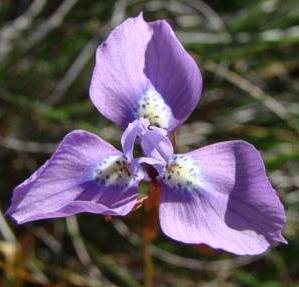Moraea tripetala
Moraea tripetala (L.f.) Ker Gawl.
Family: Iridaceae
Common names: blue tulp (Eng.); blou-uintjie, kleinuiltjie, bok-uintjie, riet-uintjie (Afr.)
Introduction
Moraea tripetala is tolerant of various environmental conditions; it is equally successful in the wetter Cape mountains and in the semi-arid areas of the western Karoo.

Description
Description
Moraea tripetala is a slender geophyte, 100-500 mm high, with one or more branches. Leaves are solitary and rarely in pairs, inserted at the base, channelled and usually longer than the stem, but trailing. Flowers range from pale to dark blue to purple, occasionally pale pink or yellow and sometimes even white, usually with yellow and white nectar guides. Seeds are angular, varying in size from medium to small. Flowering time is late winter, spring and early summer (August to October to December).
Conservation Status
Status
Moraea tripetala is very widespread and abundant and is assessed as Least Concern (LC). (Raimondo et al. in prep.)
Distribution and habitat
Distribution description
Moraea tripetala has a very wide distribution; it extends from Loeriesfontein in the western Karoo, throughout the Cape Peninsula and eastwards as far as Humansdorp. Unlike most Cape species it is tolerant of weather extremes and occurs from semi-arid to wetter areas in the winter rainfall area. It also ranges from low elevations near the sea to the higher Cape mountains and occurs on both clay and sandy soils. The species can be considered the most successful species of the genus.

Derivation of name and historical aspects
History
The species name, tripetala, means with three tepals, referring to the three visible outer tepals. The inner petals appear to be absent, but are actually much reduced. Moraea resembles the Iris in many ways, but is not related to the northern hemisphere genus. The genus is more closely related to Dietes and Ferraria.
Moraea tripetala has been known to botanists since the late seventeenth century. The species was not known to Linnaeus and was only described after his death by his son in 1782. The specimen was collected by Thunberg during his four years of exploration at the Cape.
The genus Moraea consists of some 200 species distributed throughout sub-Saharan Africa, with two outlier species in the Mediterranean and the Middle East. The highest concentration is in the Western Cape with about 180 species.

Ecology
Ecology
Moraea tripetala is not scented and is mostly visited by bees.

Growing Moraea tripetala
Grow
Moraea tripetala grows easily from seed, collected in late spring. Sow seeds in late summer or early autumn in a well-drained soil mix. From seeds to flowering takes about three years. Transplant corms in the full sun, clustered together to get a good display.
References
- Goldblatt, P., Bernhardt, P. & Manning, J. 2005. Pollination mechanisms in the African genus Moraea (Iridaceae, Iridoideae): floral divergence and adaptation for pollinators. Adansonia, ser. 3, 27,1: 21-47.
- Leistner, O.A. (ed.). 2000. Seeds plants of southern Africa : families and genera. Strelitzia 10. National Botanical Institute, Pretoria.
- Manning, J. & Goldblatt, P. 2007. Nieuwoudtville: Bokkeveld Plateau and Hantam. South African Wild Flower Guide 9. Botanical Society of South Africa, Cape Town.
Credits
Eugene Marinus
Hantam National Botanical Garden
October 2009
Plant Attributes:
Plant Type: Bulb
SA Distribution: Northern Cape, Western Cape
Soil type: Sandy, Clay, Loam
Flowering season: Spring
PH: Acid, Neutral
Flower colour: Blue, Purple, Mauve/Lilac
Aspect: Full Sun
Gardening skill: Average
Special Features:
Horticultural zones









Rate this article
Article well written and informative
Rate this plant
Is this an interesting plant?
Login to add your Comment
Back to topNot registered yet? Click here to register.